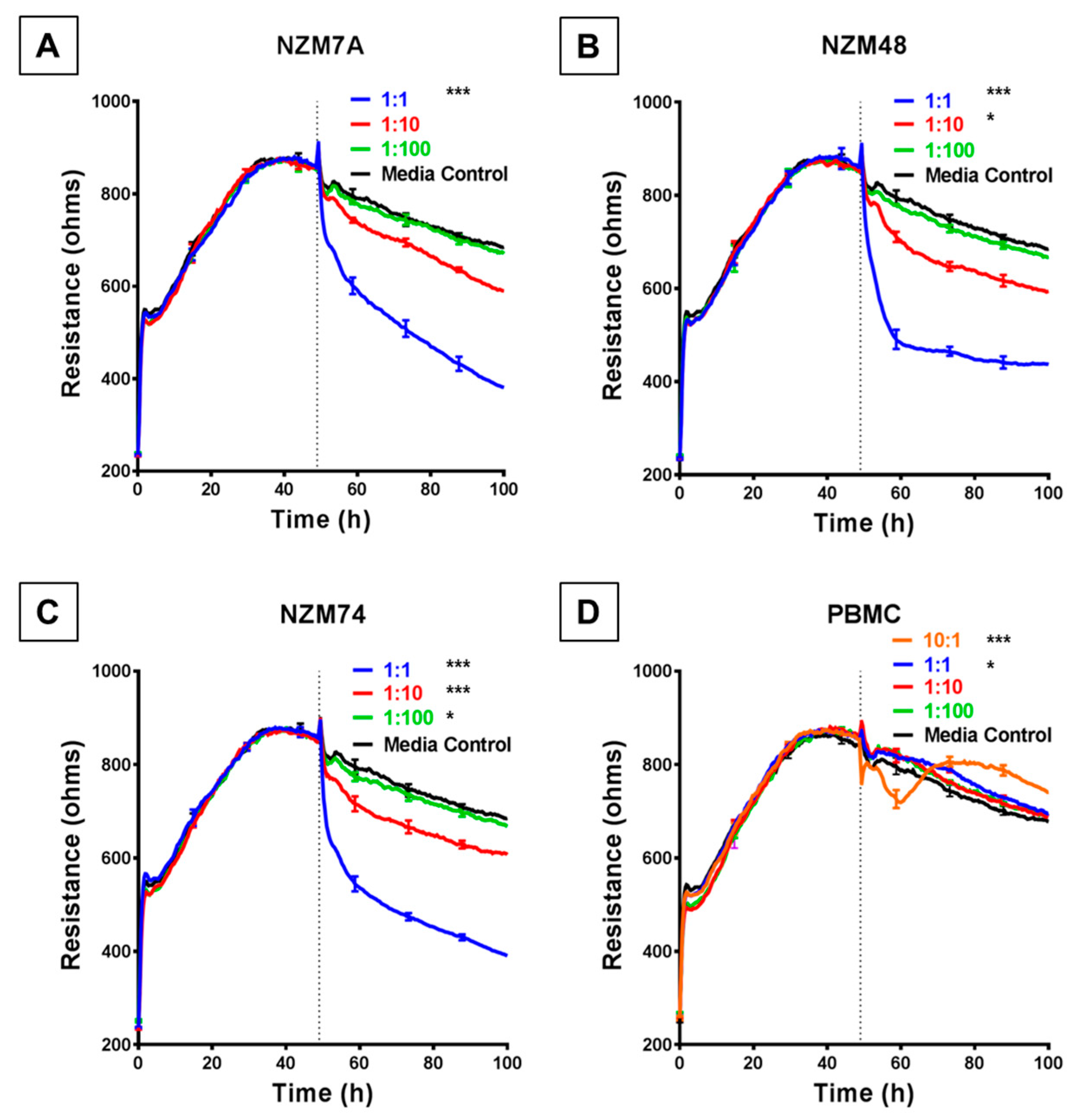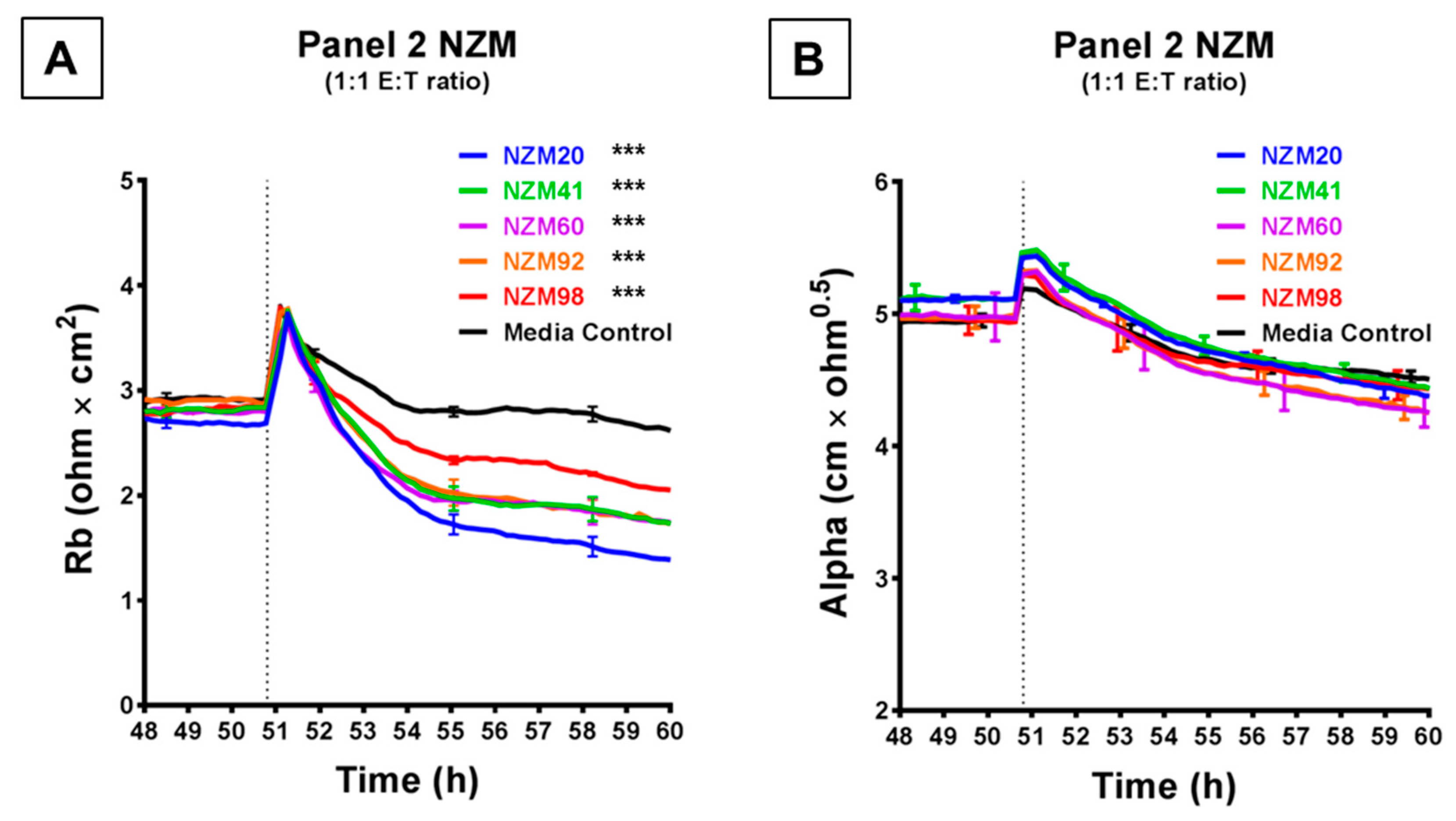Real-Time Measurement of Melanoma Cell-Mediated Human Brain Endothelial Barrier Disruption Using Electric Cell-Substrate Impedance Sensing Technology
Abstract
1. Introduction
1.1. The Structural Composition of the Blood–Brain Barrier
1.2. Current Understanding of Paracellular Melanoma Metastasis into the Brain
1.3. The Utility of Electric Cell-Substrate Impedance Sensing (ECIS)
1.4. Research Aims
2. Materials and Methods
2.1. Cell Culture
2.1.1. Human Cerebral Microvascular Endothelial Cells (hCMVECs)
2.1.2. New Zealand Melanoma (NZM) Cells
2.1.3. Peripheral Blood Mononuclear Cells (PBMCs)
2.2. Electrical Cell-Substrate Impedance Sensing (ECIS)
2.2.1. ECIS Setup
2.2.2. Addition of Cells onto the hCMVECs
2.2.3. Addition of Melanoma-Conditioned Medium onto the hCMVECs
2.3. Immunocytochemistry
2.4. Live-Cell Imaging
2.5. Statistics
3. Results
3.1. Decrease in Brain Endothelial Barrier Strength upon Addition of Melanoma Cells
3.2. Modelled Decrease in Brain Endothelial Barrier Strength upon Addition of Melanoma Cells
3.3. Decrease in Brain Endothelial Barrier Strength upon Addition of Melanoma Cell-Conditioned Medium
3.4. Melanoma Cells Rapidly Localise to the Junctional Space of Human Microvascular Endothelial Cells
3.5. Time-Lapse of Melanoma and Brain Endothelial Cell Co-Culture
3.6. Melanoma-Mediated Retraction of Brain Endothelial Cells in Co-Culture
4. Discussion
4.1. Melanoma Cell-Mediated Effects on the Barrier Are Often Rapid – Importance of Real-Time Data
4.2. Melanoma Cell-Mediated Barrier Effects Are Cell Number-Dependent – Importance of ECIS Sensitivity
4.3. Melanoma Cell-Mediated Effect Is Variable – Importance of ECIS Modelling
4.4. Factors Secreted by the Melanoma Cells also Effect the Endothelial Barrier
4.5. ECIS Data Predict a Dominant Effect of the Melanoma Cells on the Paracellular Barrier
5. Conclusions
Supplementary Materials
Author Contributions
Funding
Conflicts of Interest
Appendix A
| Reagent | Company | Catalogue Number |
|---|---|---|
| Collagen I – rat tail | Gibco | A1048301 |
| M199 | Gibco | 11150-067 |
| FBS | Sigma-Aldrich | 12203C-500ML |
| Hydrocortisone | Sigma-Aldrich | H0888 |
| hFGF | PeproTech | PTAF10018B50 |
| hEGF | PeproTech | PTAF10015100 |
| Heparin | Sigma-Aldrich | H-3393 |
| GlutaMAX | Gibco | 305050-061 |
| dibutyryl-cAMP | Sigma-Aldrich | D0627 |
| aMEM | Gibco | 12561072 |
| Insulin-Transferrin-Sodium Selenite | Sigma-Aldrich | 11074547001 |
| RPMI 1640 media | Gibco | 11875093 |
| Panel | New Zealand Melanoma Cell line | Research Resource ID |
|---|---|---|
| 1 | NZM48 | CVCL_S423 |
| 1 | NZM7 or NZM7A | CVCL_D843 |
| 1 | NZM74 | CVCL_0D38 |
| 2 | NZM20 | CVCL_D824 |
| 2 | NZM41 | CVCL_S426 |
| 2 | NZM60 | CVCL_S416 |
| 2 | NZM92 | CVCL_0D52 |
| 2 | NZM98 | CVCL_0D58 |
References
- Stelzer, K. Epidemiology and prognosis of brain metastases. Surg. Neurol. Int. 2013, 4, 192. [Google Scholar] [CrossRef] [PubMed]
- Goulart, C.; Mattei, T.; Ramina, R. Cerebral Melanoma Metastases: A Critical Review on Diagnostic Methods and Therapeutic Options. ISRN Surg. 2011, 2011, 276908. [Google Scholar] [CrossRef] [PubMed]
- Sloan, A.; Nock, C.; Einstein, D. Diagnosis and Treatment of melanoma Brain Metastasis: A Literature Review. Cancer Control 2009, 16, 248–255. [Google Scholar] [CrossRef] [PubMed]
- Barreiro, O.; Sánchez-Madrid, F. Molecular Basis of Leukocyte–Endothelium Interactions During the Inflammatory Response. Revista Española de Cardiología 2009, 62, 552–562. [Google Scholar] [CrossRef]
- Fazakas, C.; Wilhelm, I.; Nagyőszi, P.; Farkas, A.E.; Haskó, J.; Molnar, J.; Bauer, H.; Bauer, H.-C.; Ayaydin, F.; Dung, N.T.K.; et al. Transmigration of Melanoma Cells through the Blood-Brain Barrier: Role of Endothelial Tight Junctions and Melanoma-Released Serine Proteases. PLoS ONE 2011, 6, e20758. [Google Scholar] [CrossRef] [PubMed]
- Keese, C.; Bhawe, K.; Wegener, J.; Giaever, I. Real-Time Impedance Assay to Follow the Invasive Activities of Metastatic Cells in Culture. BioTechniques 2002, 33, 842–850. [Google Scholar] [CrossRef] [PubMed]
- Amatschek, S.; Lucas, R.; Eger, A.; Pflueger, M.; Hundsberger, H.; Knoll, C.; Grosse-Kracht, S.; Schuett, W.; Koszik, F.; Maurer, D.; et al. CXCL9 induces chemotaxis, chemorepulsion and endothelial barrier disruption through CXCR3-mediated activation of melanoma cells. Br. J. Cancer 2010, 104, 469–479. [Google Scholar] [CrossRef] [PubMed]
- Robilliard, L.; Kho, D.; Johnson, R.; Anchan, A.; O’Carroll, S.; Graham, E. The Importance of Multifrequency Impedance Sensing of Endothelial Barrier Formation Using ECIS Technology for the Generation of a Strong and Durable Paracellular Barrier. Biosensors 2018, 8, 64. [Google Scholar] [CrossRef] [PubMed]
- Marshall, E.; Matthews, J.; Shaw, J.; Nixon, J.; Tumewu, P.; Finlay, G.; Holdaway, K.; Baguley, B. Radiosensitivity of new and established human melanoma cell lines: Comparison of [3H]thymidine incorporation and soft agar clonogenic assays. Eur. J. Cancer 1994, 30, 1370–1376. [Google Scholar] [CrossRef]
- Giaever, I.; Keese, C. Micromotion of mammalian cells measured electrically. Proc. Natl. Acad. Sci. USA 1991, 88, 7896–7900. [Google Scholar] [CrossRef] [PubMed]
- Benson, K.; Cramer, S.; Galla, H. Impedance-based cell monitoring: Barrier properties and beyond. Fluids Barriers CNS 2013, 10. [Google Scholar] [CrossRef] [PubMed]
- Mumford, B.; Robertson, G. Circulating Melanoma Cells in the Diagnosis and Monitoring of Melanoma: An Appraisal of Clinical Potential. Mol. Diagn. Ther. 2013, 18, 175–183. [Google Scholar] [CrossRef] [PubMed]









© 2019 by the authors. Licensee MDPI, Basel, Switzerland. This article is an open access article distributed under the terms and conditions of the Creative Commons Attribution (CC BY) license (http://creativecommons.org/licenses/by/4.0/).
Share and Cite
Anchan, A.; Kalogirou-Baldwin, P.; Johnson, R.; Kho, D.T.; Joseph, W.; Hucklesby, J.; Finlay, G.J.; O’Carroll, S.J.; Angel, C.E.; Graham, E.S. Real-Time Measurement of Melanoma Cell-Mediated Human Brain Endothelial Barrier Disruption Using Electric Cell-Substrate Impedance Sensing Technology. Biosensors 2019, 9, 56. https://doi.org/10.3390/bios9020056
Anchan A, Kalogirou-Baldwin P, Johnson R, Kho DT, Joseph W, Hucklesby J, Finlay GJ, O’Carroll SJ, Angel CE, Graham ES. Real-Time Measurement of Melanoma Cell-Mediated Human Brain Endothelial Barrier Disruption Using Electric Cell-Substrate Impedance Sensing Technology. Biosensors. 2019; 9(2):56. https://doi.org/10.3390/bios9020056
Chicago/Turabian StyleAnchan, Akshata, Panagiota Kalogirou-Baldwin, Rebecca Johnson, Dan T Kho, Wayne Joseph, James Hucklesby, Graeme J Finlay, Simon J O’Carroll, Catherine E Angel, and E Scott Graham. 2019. "Real-Time Measurement of Melanoma Cell-Mediated Human Brain Endothelial Barrier Disruption Using Electric Cell-Substrate Impedance Sensing Technology" Biosensors 9, no. 2: 56. https://doi.org/10.3390/bios9020056
APA StyleAnchan, A., Kalogirou-Baldwin, P., Johnson, R., Kho, D. T., Joseph, W., Hucklesby, J., Finlay, G. J., O’Carroll, S. J., Angel, C. E., & Graham, E. S. (2019). Real-Time Measurement of Melanoma Cell-Mediated Human Brain Endothelial Barrier Disruption Using Electric Cell-Substrate Impedance Sensing Technology. Biosensors, 9(2), 56. https://doi.org/10.3390/bios9020056






